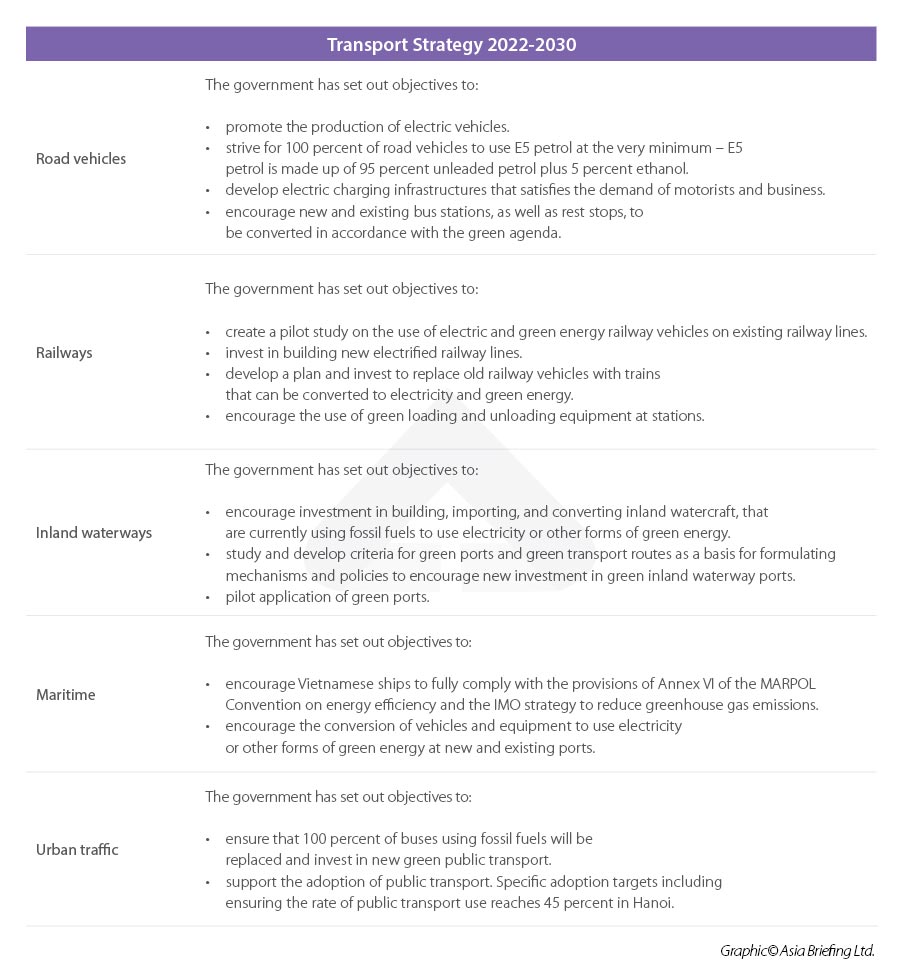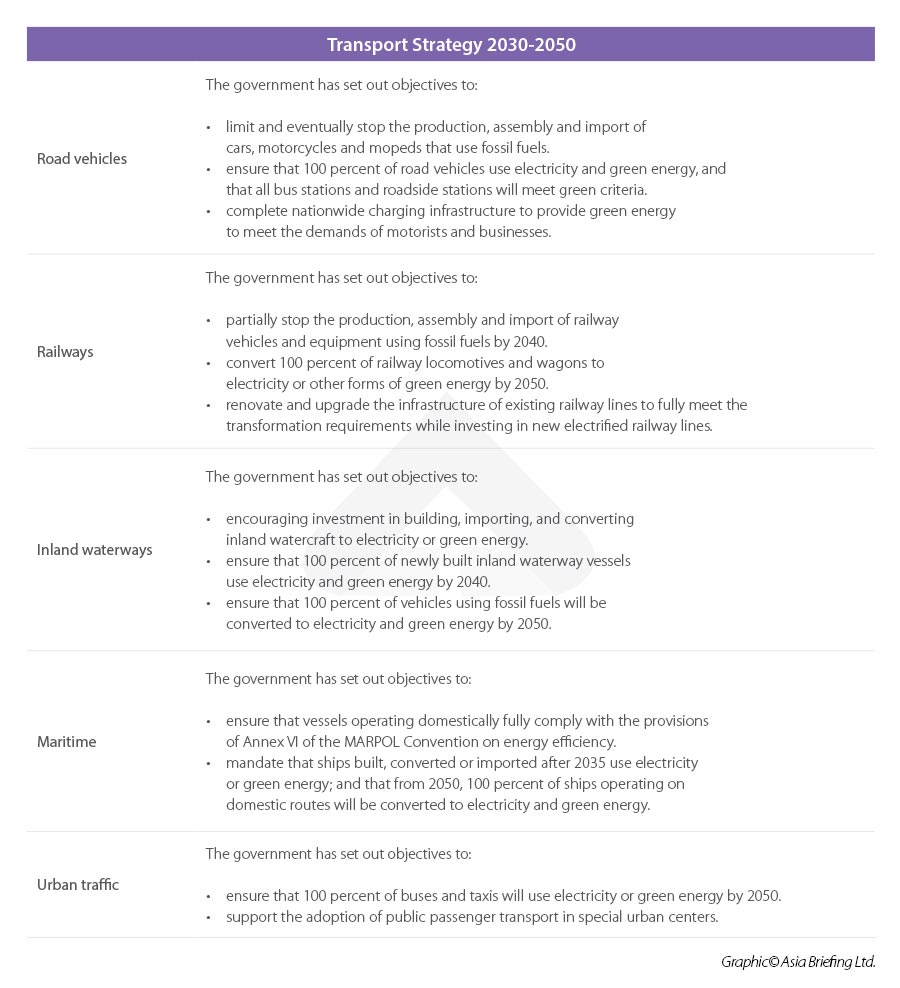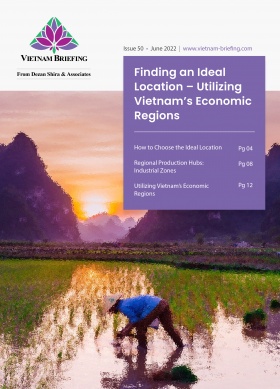Vietnam’s Target for Carbon-Neutral Transportation: Opportunities and the Path Forward
This article is part of our partnership with the Green Economy Forum & Exhibition 2022, organized by EuroCham Vietnam, supported by Dezan & Associates Vietnam.
Vietnam will soon be embarking on a considerable project, costing more than US$100 billion, following the recent approval of plans to reach carbon-neutrality in transport. The government has set out its targets and now requires ministries and partners to come together to develop plans and realize the state’s ambitious, but necessary objectives.
In July, Vietnam’s Deputy Prime Minister Le Van Thanh approved an action plan to reduce carbon emissions in transportation as part of the country’s wider strategy to actualize its climate change commitments made at the 26th UN Climate Change Conference of the Parties (COP26). At the conference, Prime Minister Pham Minh Chinh pledged that Vietnam would strive to achieve net-zero emissions by 2050.
The government’s strategy will see a gradual reduction in the manufacture, assembly, and import of fossil-fueled vehicles. By 2050, all transport will run on electricity or another form of green energy, such as hydrogen power. The transformation of the transport sector requires substantial investment in all parts of the transport ecosystem, from a network of electric vehicle charging stations to the complete overhaul of mature railway assets.
Vietnam has already underscored its commitment to climate change and has been a dark horse in the global green energy transition. Countries in Southeast Asia are among those most vulnerable to the impact of climate change, but the region as a whole is still largely dependent on fossil fuels. In fact, all but two of the most polluted cities in the world are in Asia – the majority in India.
However, Vietnam is leading the transition in the region. Between 2017 and 2021, the share of electricity generated by photovoltaic (solar) technology in Vietnam increased from practically nothing to nearly 11 percent, making the country the tenth-biggest producer of solar power worldwide.
Vietnam’s near-term strategy (2022-2030)
The government has divided its objectives into near-term (2022-2030) and long-term (2030-2050). These objectives can be broadly categorized to correspond to road vehicles, railway travel, inland waterways, sea traffic, and urban transport.
Vietnam’s long-term strategy (2030-2050)
Vietnam’s long-term strategy hopes to actualize meaningful objectives in reaching net zero greenhouse gas emissions by 2050. The state has set lofty objectives in each transport category to ensure that their wider aims are achieved.
Once again, the government has divided objectives by the relevant transport sector.
The policy paper even includes references to the aviation industry and highlights the government’s desire to develop a program to ensure the use of green or sustainable fuel within the industry.
Partners and private participation
The resources required to implement Vietnam’s net zero project will be raised from a number of sources, including the state budget, multilateral investment, private investment, and public-private partnerships.
Under the plan, 11 key projects will require a total investment estimated at more than VNĐ3 quadrillion (US$128 billion). The project cost is roughly equivalent to half of the country’s Gross Domestic Product (GDP) – GDP reached US$272 million in 2020.
Agence Française de Développement (AFD), the Asian Development Bank (ADB), the World Bank, and HSBC are among partners that have expressed their interest in supporting Vietnam in advancing green and sustainable development, according to Vietnamese media. Many international organizations, both public and private, are mandated by their own boards, investors or agreed strategies to ensure that green investments make up a certain proportion of the investment portfolio.
The government has also highlighted the need to seek closer cooperation with external partners, not just on financing issues. The policy paper highlights the desire to actively participate in the development of common international regulations and standards for the green transportation sector. The state also hopes to benefit from advanced technology transfer and learn from peers in the industry.
Opportunities for business
A major part of the government’s strategy revolves around encouraging the production and procurement of electric vehicles, and other forms of green transport. In fact, there have already been developments in this area. In 2021, the government proposed halving the vehicle registration fee to encourage the manufacture and uptake of electric vehicles.
There are clear beneficiaries of such policies – manufacturers, customers, as well as the environment. Vietnam’s indigenous EV manufacturer, VinFast, is among the companies that are likely to benefit the most. The firm is actually investing substantially in upscaling its production. VinFast recently announced that it is planning a new factory in the US in an attempt to sell its EVs into a larger and wealthier market.
VinFast, a member of the conglomerate organization Vingroup, is also playing a considerable role in the development of green infrastructure in Vietnam. The Vietnamese automaker will also be installing some 300 charging stations at PVOIL petrol stations, nationwide, this year.
Green Batteries Remake PTY, a Vietnamese battery producer that uses scrap metal, may also be able to benefit from the project. Although, the firm will likely face stiff competition from larger and international battery producers.
Other beneficiaries of Vietnam’s net-zero program could potentially include rolling stock manufacturers such as China’s CRRC Corporation, France’s Alstom Power, or the UK’s innovative Vivarail – a world-leading manufacturer in emission-free battery and battery hybrid trains.
More broadly, the infrastructure development in Vietnam to follow through on the government’s ambitious roadmap will generate opportunities for several firms in the green energy sector, including those involved in the creation and manufacture of photovoltaics and wind power. After all, the electrification of road, rail, and maritime transport is arguably incomplete if the power supply comes from non-renewable sources. Companies like Denmark’s Vestas Wind Systems or the UK’s SSE Renewables may also benefit here.
The Vietnamese government has also highlighted the need to train and retrain personnel to ensure there is the human capacity to actualize the state’s targets in transportation. This will be done by creating new training disciplines at universities, colleges, and vocational schools, as per the official policy document. The market for education and training in the green infrastructure sector alone is considerable. Many training businesses around the world provide accredited courses in such areas. It is also important to note that some sectors will require advanced HSE certification.
The way forward
The government and relevant ministries will now be tasked with bringing in policies, regulations, and initiatives to actualize the objectives stated in the recently approved plans. The state will also need to arrange financing to ensure it has the capital to go through with its net zero transportation projects.
About Us
Vietnam Briefing is produced by Dezan Shira & Associates. The firm assists foreign investors throughout Asia from offices across the world, including in Hanoi, Ho Chi Minh City, and Da Nang. Readers may write to vietnam@dezshira.com for more support on doing business in Vietnam.
We also maintain offices or have alliance partners assisting foreign investors in Indonesia, India, Singapore, The Philippines, Malaysia, Thailand, Italy, Germany, and the United States, in addition to practices in Bangladesh and Russia.
- Previous Article Vietnam’s Nam Dinh Province: Investment Opportunities in the Red River Delta
- Next Article The Euro’s Depreciation: What Should Businesses in Vietnam Expect









